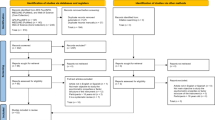Abstract
The 1956 adaptation for children of Taylor's Manifest Anxiety Scale, the Children's Manifest Anxiety Scale, was revised to meet current psychometric standards. A 73-item revision draft was administered to 329 school children from grades 1 to 12. Based on item-analysis criteria for rbis≥.4 and .30≤p≤.70, 28 anxiety items were retained along with 9 of the original 11 Lie scale items. A cross-validation sample of 167 children from grades 2, 5, 9, 10, and 11 produced a KR20 reliability estimate of .85. Anxiety scores did not differ across grade or race. Females scored significantly higher than males. For the Lie scale, significant differences appeared by grade and race. No sex differences were obtained on the Lie scale. The resulting scale appears useful for children in grades 1 to 12 and may aid in future studies of anxiety as well as assisting the clinician in the understanding of individual children.
Similar content being viewed by others
Reference note
Stanwyck, D. J., & Felker, D. W.Intellectual achievement, responsibility, and anxiety as functions of self-concept of third to sixth grade boys and girls. Paper presented at AERA, New York, 1973.
References
Allison, D. E. Test anxiety, stress, and intelligence-test performance.Canadian Journal of Behavioral Science, 1970,2(11), 26–37.
American Psychological Association.Standards for educational and psychological tests. Washington, D. C., 1974.
Bledsoe, J. C. Sex and grade differences in children's manifest anxiety.Psychological Reports, 1973,32, 285–286.
Boyce, M. W. Student teacher misconceptions of manifestations of anxiety in children from different socio-economic/ethnicity backgrounds.Australian and New Zealand Journal of Sociology, 1974,10(2), 138–139.
Brady, P. J., Richards, J. P., & Felker, D. W. Affective outcomes of evaluation strategies by self and another in children's learning from textbook material.Psychological Reports, 1975,37(1), 311–317.
Carrier, N. A., Orton, D. D., & Malpass, L. F. Responses of bright, normal, and EMR children to an orally-administered Children's Manifest Anxiety Scale.Journal of Educational Psychology, 1962,53, 271–274.
Castaneda, A., McCandless, B. R., & Palermo, D. S. The children's form of the manifest anxiety scale.Child Development, 1956,27(3), 317–326. (a)
Castaneda, A., Palermo, D. S., & McCandless, B. R. Complex learning and performance in children as a function of anxiety in children and task difficulty.Child Development, 1956,27(3), 327–332. (b)
Chansky, N. M. Anxiety, intelligence, and achievement in algebra.Journal of Educational Research, 1966,60, 90–91.
Cochran, I. L., and Cleland, C. C. Manifest anxiety of retarded and normals matched to academic achievement.American Journal of Mental Deficiency, 1963,67, 539–542.
Donald, D. R. Anxiety in the relationship of group-acceptance to the academic achievement of pre-adolescents.Psychologia Africana, 1973,15, 1–6.
Ebel, R. L.Measuring educational achievement. Englewood Cliffs, New Jersey: Prentice-Hall, 1965.
Finch, A. J., Montgomery, L. E., & Deardoff, P. A. Children's Manifest Anxiety Scale: Reliability with emotionally disturbed children.Psychological Reports, 1974,34, 68.
Flanigan, P. J., Peters, C. J., & Conry, J. L. Item analysis of the Children's Manifest Anxiety Scale with the retarded.Journal of Educational Research, 1969,62(10), 472–477.
Gaudry, E., & Spielberger, D.Anxiety and educational achievement. Sydney, Australia: Wiley, 1971.
Guilford, J. P.Psychometric methods (2nd ed.). New York: McGraw-Hill, 1954.
Kirk, R. E.Experimental design: Procedure for the behavioral sciences. Belmont California: Brooks/Cole, 1968.
Kitano, H. L. Validity of the Children's Manifest Anxiety Scale and the modified revised California inventory.Child Development, 1960,31, 67–72.
McCall, R. B.Fundamental statistics for psychology (2nd ed.). Atlanta: Harcourt Brace Jovanovich, 1975.
Melamed, B. G., & Siegel, L. J. Reduction of anxiety in children facing hospitalization and surgery by use of filmed modeling.Journal of Consulting and Clinical Psychology, 1975,43(4), 511–521.
Merryman, E. P. The effects of manifest anxiety on the reading achievement of fifth grade students.Journal of Experimental Education, 1974,42(3), 36–41.
Muralidharan, R., & Sharma, A. Manifest anxiety in Indian (Delhi) children.Indian Educational Review, 1971,6(2), 67–68.
Palermo, D. S., Castaneda, A., & McCandless, B. R. The relationship of anxiety in children to performance in a complex learning task.Child Development, 1956,27(3), 333–337.
Peck, R. F., & Mitchell, J. V.Mental health: What research says to the teacher. Washington, D. C.: National Educational Association of Classroom Teachers, 1967.
Sarason, S. B., Davidson, K. S., Lightthall, F. F., Waite, R. R., & Ruebush, B. K.Anxiety in elementary school children. New York: Wiley, 1960.
Taylor, J. A. The relationship of anxiety to the conditioned eyelid response.Journal of Experimental Psychology, 1951,42, 183–188.
Ziv, A., & Luz, M. Manifest anxiety in children of different socioeconomic levels.Human Development, 1973,16(2), 24–32.
Ziv, O., & Shauber, H. Contribution to a cross-cultural study of manifest anxiety in children.Human Development, 1969,12, 178–191.
Author information
Authors and Affiliations
Rights and permissions
About this article
Cite this article
Reynolds, C.R., Richmond, B.O. What i think and feel: A revised measure of children's manifest anxiety. J Abnorm Child Psychol 6, 271–280 (1978). https://doi.org/10.1007/BF00919131
Revised:
Issue Date:
DOI: https://doi.org/10.1007/BF00919131




